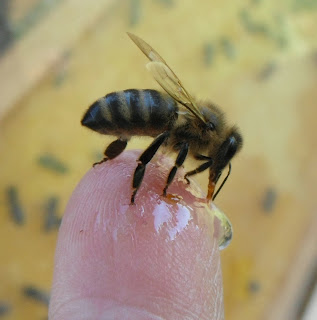I give them sugar syrup for two reasons, one so that they can top up resources and second so that I can medicate with Fumigilin B for Nosema.
I have used both hive top feeders and sugar baggies. And I'm not happy with either one of them.
[sugar baggies placed on top bars in 2011]
I did like the Styrofoam hive top feeder at first but I soon found that wasps and ants can all too easily chew holes through the Styrofoam creating leaks.
I spent so much time duct taping and melting wax to plug the holes only to find this type of feeder kept leaking.
I found the wooden feeders leak and the baggies leak too.
I can't tell you how many times I've carefully filled and sealed a baggie and laid it on the hive. I made sure my slits were small so it wouldn't leak. I'd close up the hive and then look down a the platform and hour later to see a puddle. A finger in the liquid and taste would confirm the baggie leaked.
The feeding is done in early spring or fall when it's cold and it's not acceptable to have liquid dripping over the bees.
For quite a while I've been thinking about how to use a baggie and prevent leaking or dripping. I finally came up with a solution. I bought plastic and cut squares about 12" x 12". Then I folded the corners up and stitched the corners - forming a tray with sides. Then I filled a baggie and set it inside the plastic tray. If the baggie leaked, the plastic tray would hold the liquid.
[My new method using a plastic tray that the baggie sits in. The reason to use plastic is because I want to keep it thin so it's close to the bees and warmed by their bodies].
The other part of the plan was to put syrup in a Styrofoam feeder and set it out on the robbing table.
While carrying my large stock pot the 50' to the robbing table I stepped carefully through the long grass. When I had only three or four more feet to go my foot caught on a tree stump and I fell. The syrup went up in the air and splashed all over me. I had it in my hair and all over my face, glasses and shirt. What a sticky mess.
Unhurt, I discovered there was still 3 or 4" of syrup in the pot so I took it and poured it into the feeder. It was a new Styrofoam feeder I bought this spring.
I worked in the yard for a couple hours and came back to check the feeder. It was empty. The robbing table was soaking wet with syrup. It had leaked out completely.
Oh yes, I have had it up to here with those feeders.
On the up side, I checked my plastic trays and they are working well. The bees are eating the syrup.
I'll be able to experiment with them more in the spring.























